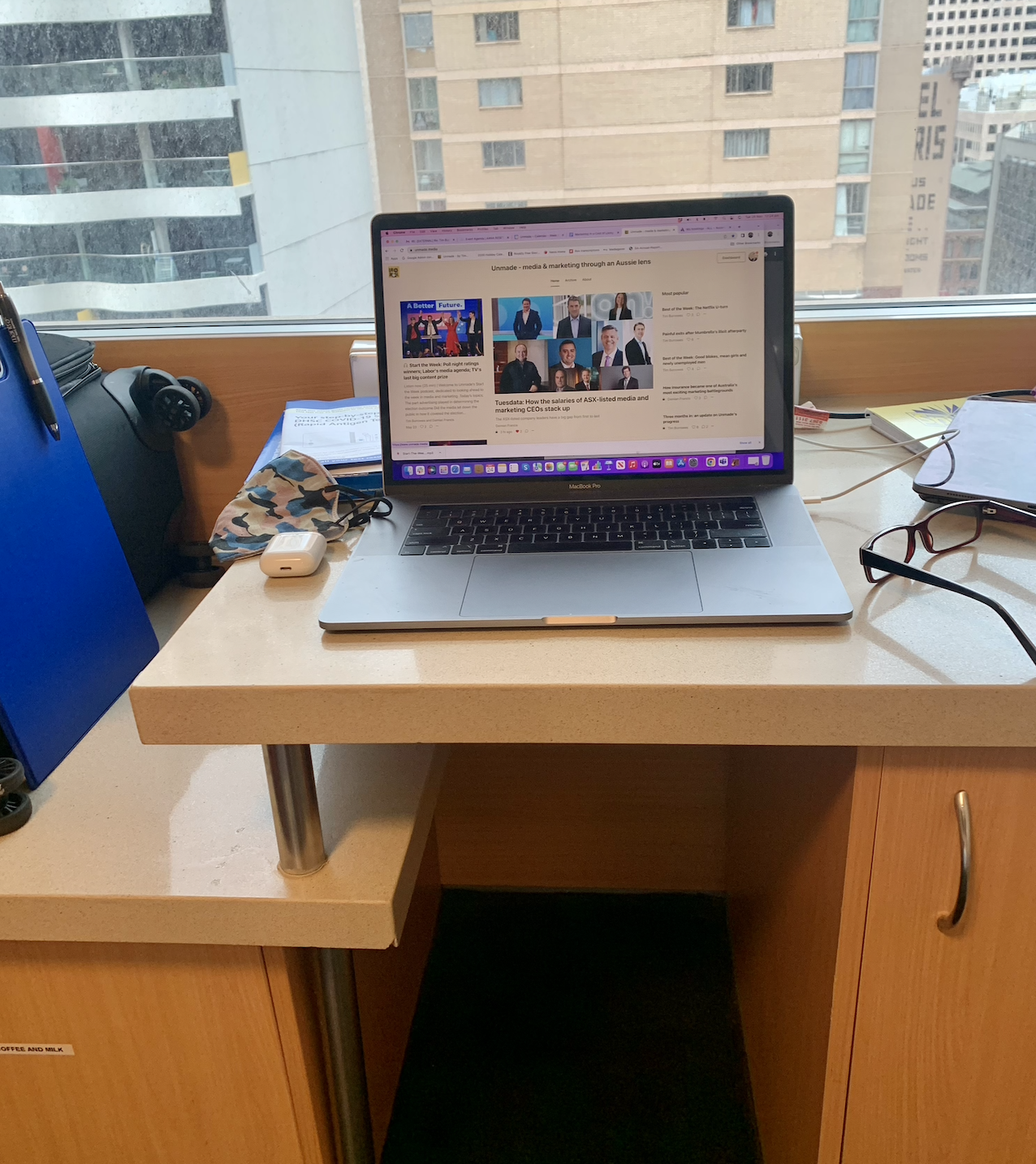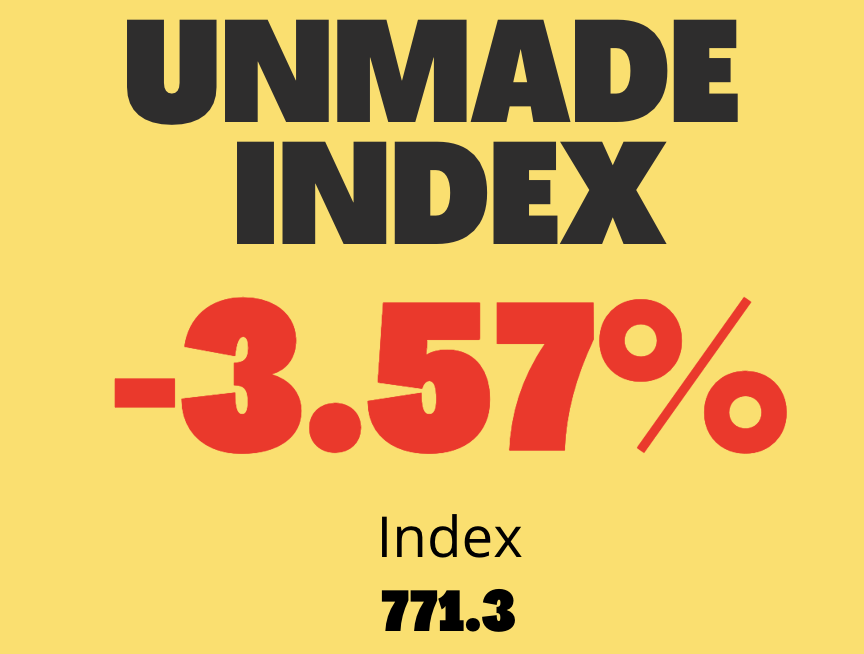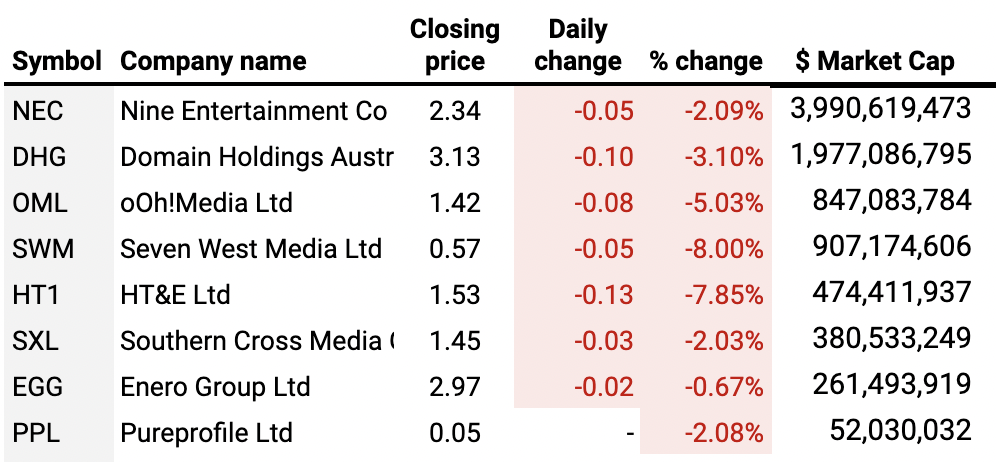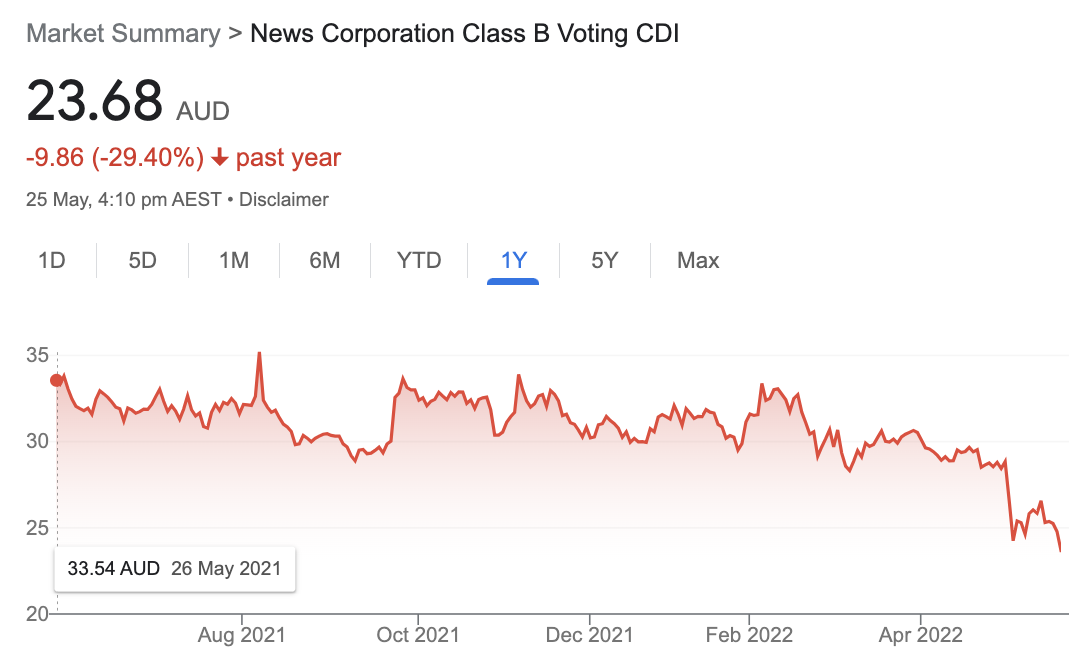Trust fails are bad for ratings too; The ASX bloodbath worsens for media stocks
Welcome to Unmade, mostly written on Wednesday while sitting at the world’s tiniest hotel room desk. Ibis is doing its bit to discourage manspreading..

If you want to support independent analysis of the communications industry, and receive Unmade’s exclusive member-only content, please do consider subscribing.
Members of Unmade’s paying tier received this email at least an hour before everyone else.
Trusting the news
Regular readers of this email will be aware that I have a tendency to go long. I exhibited the same tendency when I was writing my book. So before submitting the manuscript for Media Unmade, I needed to remove some chunks I was quite pleased with.
The excerpt that follows was one of those did not make it in to the final edit. But the topic it covers is relevant today. I’ll get to that after the extract…
Choppergate
It’s 2011 and nothing is going right for Nine. On August 22 an email arrives in my inbox that will mean that four Nine News journalists will lose their jobs before the week is out.
Over the weekend, police searching for missing teenager Daniel Morcombe have found human remains near the Sunshine Coast hinterland town of Beerwah.
The Monday morning email to Mumbrella from one of Nine’s rival television networks includes a video file. It shows a split screen.
One side of the split screen features the Nine News Brisbane Sunday night bulletin. Presenter Eva Milic introduces the story about the search, and crosses live to journalist Cameron Price on board the Nine News chopper. The caption informs viewers that the chopper is hovering “near Beerwah”. Price completes his report and hands back to Milic in the studio.
The other side of the split screen shows grainy footage of the Nine News helipad in the darkness at Mt Coot-Tha, some 90 km from the search site. The Nine News chopper, with rotor turning, is parked is at one end of the helipad. Twenty seconds after the live cross ends, the helicopter’s main lights come back on and the chopper moves back along the helipad. The live cross was faked.
Initially, Nine tries to bluff it out. The network emails a statement: “Our chopper was forced to divert from Beerwah due to bad weather, and air control instructed them to touch down. The decision was made by the pilot on safety grounds. The producer was unaware until it was too late to abort or delay the cross.”
It’s a risky strategy. Audience trust in the Nine News and Seven News brands is vital for both networks in the close fought daily 6pm news battle.
The spokesman correctly guesses the source of the video, adding: “Seven know this because they have a camera permanently monitoring our pad.”
The level of enmity between the two networks is at an all time high. The TV networks are beating each other up so regularly that the reputation of the whole TV sector is being dragged down. Mumbrella is not the only trade media publication to be regularly receiving those sort of video clips from the networks featuring rivals’ stuff ups.
The next day, things get worse for Nine. A second video arrives by email.
This time it shows a split screen of the Nine News Saturday night bulletin, alongside a flight tracker of the chopper’s route.
Milic crosses to reporter Melissa Mallet in the chopper. Like the Sunday night bulletin, the caption says “Near Beerwah”.
The flight data demonstrates that this time the chopper was at least in the air, but hovering 3,000 feet above Chapel Hill, near Nine’s Brisbane headquarters. Once the cross was over, it had landed again.
With the new evidence, Nine owns up. Brisbane news director Lee Anderson puts out a stern statement: “During Saturday and Sunday night’s Brisbane bulletin we crossed live to a reporter in our helicopter updating the Daniel Morcombe case.
“On both occasions we said the helicopter was near Beerwah. This was not the case. The fact that the location was misreported is totally unacceptable. We have launched a thorough investigation into all the facts surrounding these reports. Independent of the outcome of that investigation and the action which flows from it, Nine News affirms its unequivocal commitment to complete accuracy in News reporting and to maintaining the trust of our viewers. Nothing less will be tolerated.
The next day Price, Mallet and producer Aaron Wakeley are all fired. Anderson, who it later transpires was not even on duty when fake crosses occurred, resigns.
Trust matters – even in commercial television
The thing about commercial TV news is the networks do not invest in the journalism just for the sake of it. They do it for the long term health of their audiences. Viewer trust matters for the bottom line, not just some journalistic ideal.
One of broadcast television’s enduring secret weapons is habit. If a viewer usually tunes in to the 6pm news, you can be sure that they’ll choose the same channel as starting point every day – or at least until something happens to make them reconsider their choice. The same goes for breakfast television. When it comes to being told the news, the viewers go with the people who they like and trust.
That’s the reason why, back in 2011, Nine fired those journalists mentioned in the extract above. Trust in the Nine News brand was too important to risk. Trust means ratings, and ratings mean advertisers.
Along with live sport, news & current affairs is one of the key ingredients in broadcast TV’s special sauce. The brand value of something like Nine’s 60 Minutes, built over 40 years of investing in high cost investigative journalism is huge.
This week, the political pages of Australia’s newspapers have been full of analysis on the question of whether the major political parties have learned the lesson of the election, and understood why so many voters – about a third – gave their first preferences to minor parties.
I wonder though whether mainstream TV newsrooms are asking themselves equally hard questions about their own lessons of the election. If they aren’t, I suspect their bosses are. Despite their many options, more than half of free to air viewers voted against commercial television on the night.
Over the last two years, there’s been a backlash to how the news industry gathers and disseminates its news. Much of that is as a result of audiences seeing the sausage being made more than they did in the past. Many people watched live press conferences for the first time during the pandemic. Social media was full of distaste at the level of aggression, particularly if the politician on the receiving end was somebody on their team.
For journalists, it’s easy to write that off as misunderstanding how the process works, and that it can take aggressive, repeated questions to break through a wall of platitudes. It’s also possible to dismiss it as merely the noise of an unhinged few at the extremes of social media. It’s true that there’s a lack of media literacy about how the job is done, even when journalists are sincerely working in their audience’s best interests.
Plus, there are some truly unhinged people on Twitter, using the media as a proxy for everything they’re angry about. But they are not the only ones. To dismiss it in that way misses the larger point, that the public came away thinking less of the media as a result of seeing them at work. And for those whose business model relies on the trust of the public, that’s still a problem, whether it’s fair or not.
Feeling misunderstood doesn’t solve the problem.
There are warning signals that you’d hope would trigger proper introspection in the network newsrooms. While the public tends to turn first to the ABC at important moments, on election night, it was in far greater proportion than usual. Astonishingly so in fact.
As The Australian pointed out on Monday, the ABC absolutely trounced the commercial players on election night, with an average of 910,000 metro viewers. That’s more than Nine (397,000), Seven (373,000) and Ten (an embarrassingly low 78,000) combined. I don’t think that’s happened before.
You can also consider the rise of ABC News Breakfast. It’s been closing the gap on Nine’s Today and Seven’s Sunrise. In the aftermath of the election on Monday, it beat the two commercial rivals again.
It justifies hard questions for newsrooms on whether viewers feel they are being served. Those “gotcha” moments of pop quiz questions for Anthony Albanese were classless once they became a daily sport, and they were bad for ratings too.
If you want another alarm bell, this week the Australian Communications and Media Authority found that Nine and Seven’s regional affiliates WIN and Prime both breached the impartiality rules by airing news reports campaigning for changes to the media ownership laws to suit their own interests.
It’s not just broadcast. Similar trust and credibility challenges face the news publishers. Imagine if the industry-funded Australian Press Council found its newspaper members to the same impartiality standards as television.
News Corp’s papers (with the exception of the NT News) urged readers to vote for the Coalition. It was their right to do so, but it’s not a great endorsement of the influence of newspapers in readers’ lives that the Coalition lost anyway.
Throw in Clive Palmer’s giant, wasted ad spend on those yellow UAP ads, and the last few weeks have been a woeful effectiveness case study in how not to use traditional media advertising to deliver ROI.
Nine’s newspapers, meanwhile, have their own challenges in maintaining reader trust. New Sydney Morning Herald editor Bevan Shields got off on the wrong foot in February when he insisted the paper referred to the NSW government’s closure of the train network was a strike.
Initially, he stubbornly stuck with that position internally too, as (surprisingly) leaked screenshots of the newsroom’s internal editorial Slack channel showed later.
It took a few days for him to publicly acknowledge that had been a mistake.
For what it’s worth, I think the conspiracy theorists claiming the “strike” word was chosen for political reasons were wrong. The best editors pick a course and fight harder than anybody else in the room to stick to it. Everyone wants a one degree course change, each seeming quite minor. But if the editor agrees to every one, the ship gradually drifts off course. But Shields stuck to the course a little too long.
More recently, he set a similar tone after Nine’s leadership debate broadcast, with a tweet that implied the program didn’t deserve to be criticised.
Sure, the competitors would attack it. But boy, did it deserve to be bagged. And I know that Nine’s own staff knew that too. The tribalism didn’t serve the readers.
The Twitter extremists – for whom nothing but slavish support for the party of their choice would ever be enough – might have been the most irked by that tweet. But there would also have been plenty of more middle-of-the-road subscribers who’d seen the show and know this take was one-eyed at best.
Thanks to their work of their investigative journalists, it’s still a brilliant paper which is often on the right side of issues like #MeToo. It had a notable legal victory over Craig McLachlan last week, for instance.
But if it wants to take the audience with it, it needs more humility too.
There’s no easy answer to what the mainstream media should have done differently during the election. I hope they’re thinking hard about it.
It would be too simplistic to argue that the journalists should have focused on the policies rather than the gotchas. Neither of the two major parties offered much in the way of serious new policy to talk about. Perhaps that’s why even the ABC’s Insiders was reduced to having Casey Briggs at a giant map screen plotting leaders’ travel movements between the marginals. Campaign strategy got more analytical airtime than policy. And when policy was discussed, it was almost always through the primary lens of how it would play out in the campaign, not whether it was best for the country.
The Betoota Advocate is, of course, a satirical newspaper, but it put it rather well.

It’s more than embarrassing. It’s bad for business.
The Unmade Index: It’s all red
It’s becoming repetitive to say this, but The Unmade Index sank to a new low yesterday, dropping by nearly 3.6% to 771 points. We started the index at the beginning of the year at 1000 points, so Australia’s ASX-listed media and marketing companies are now worth 23% less than they were five months ago.

Yesterday, Domain fell below its $2bn market cap for the first time since the start of the pandemic, and Southern Cross Austereo dropped to the lowest point since it consolidated its shares in early 2020.
Seven West Media saw 8% wiped off its valuation yesterday. HT&E lost nearly 8% too. Ooh Media was down 5%.

Snap Inc’s profit warning in the US has affected sentiment towards all ad-supported media globally. Most alarming was that this reversed Snapchat;’s outlook predictions given just a few weeks before. It suggests that things have turned bad, fast.
We don’t include News Corp in The Unmade Index because most of its valuation comes from its overseas holdings, but it’s worth noting that the company is going through one of its worse periods on.the sharemarket since being created by the split from 21st Century Fox in 2013. News Corp is down by nearly 30% over the last year, including a 4.5% fall yesterday.

Over the midweek hump
On that somewhat gloomy note, that’s where I’ll leave you for today.
Tomorrow we’ll be uploading a podcast of our first Unmade event, in which our entertaining panel discussed marketing during the cost of living crisis. It’s well worth hearing.
Have a great Thursday.
Toodlepip
Tim Burrowes
letters@unmade.media

